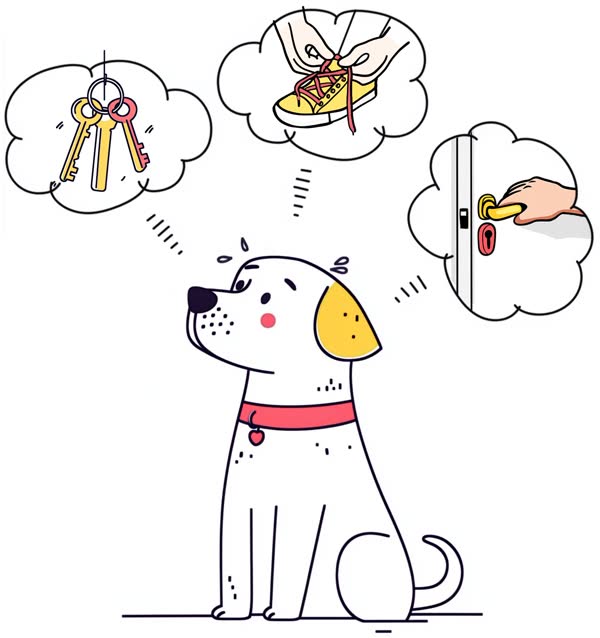Hello, and welcome, caring dog owner. Embarking on the journey of pet parenthood often entails navigating through various behavioral challenges, one of which is dog's separation anxiety. It's a common yet complex issue that can affect the well-being of both our dogs and ourselves.
This webpage is designed to provide a well-rounded understanding of dog separation anxiety. We aim to equip you with reliable information and practical solutions to better manage and alleviate the stress associated with this behavioral condition. Our goal is to bridge the gap between concern and action, offering insights that can contribute to improving the quality of life for you and your beloved dog.
As you read further, you'll find a blend of professional advice and practical tips, all aimed at fostering a better understanding of separation anxiety, its underlying causes, and the steps you can take towards creating a serene and happy environment for your dog, even during times of separation.
Introduction to Dog's Separation Anxiety
Dog's separation anxiety is a common behavioral issue many pet parents face. It occurs when dogs feel distressed or exhibit behavioral problems when separated from their human companions, even if it's just for a short while. The level of anxiety can vary greatly among dogs, with some showing mild unease, while others may experience more intense anxiety.
The signs of separation anxiety are often apparent: excessive barking or howling, destructive chewing, indoor elimination, or attempts to escape from their confined space. These behaviors can be distressing not only for the dogs but also become a source of concern and frustration for the owners.
Research highlights how widespread this issue is. Studies suggest that between 20‒40% of dogs feel anxious due to separation. This represents a significant portion of the dog-owner community facing this challenge worldwide.
Understanding separation anxiety requires looking into the close bond dogs share with their human companions. Naturally social beings, dogs form strong connections with their human families, relying on this bond for their sense of security and emotional well-being. A disruption in this bond, even for a while, can lead to significant distress.
Identifying and addressing separation anxiety early is crucial, as it can escalate over time if left unattended. Moreover, separation anxiety can notably affect the quality of life for both the dog and the owner.
In the following sections, we'll dive deeper into understanding separation anxiety, recognizing its symptoms, and exploring various ways to ease and manage this issue. We'll also look into other separation-related challenges, provide a basic guide on separation training, and talk about common hurdles in the training process. Our hope is that this guide gives you the information and steps needed for a calmer, more confident, and happier dog.
Understanding Separation Anxiety as a Syndrome

It's quite common to encounter judgments towards dog owners, with claims that they've caused the separation anxiety by "not being the leader", "spoiling the dog", or "letting it sleep in your bed" among others. However, these are not valid arguments and do not contribute to the onset of separation anxiety.
Separation anxiety in dogs is a syndrome - a collection of related behaviors triggered by the anxiety of being left alone, rooted in the dog's natural instincts and emotions. Understanding the real roots of separation anxiety requires a deeper dive into the dog's behavior and environment.
Causes
According to current knowledge, separation anxiety stems from an exceptionally strong attachment, particularly between dogs and humans. There are also historical and evolutionary aspects contributing to this issue, which we will discuss in a later chapter. However, during a dog's lifetime, certain factors might contribute to or exacerbate this condition:
- Change in Environment: A change in living environment, such as moving to a new home, can trigger separation anxiety.
- Change in Schedule: A sudden change in the schedule of the owner, leading to extended periods of separation, can also be a trigger.
- Traumatic Events: Experiencing traumatic events, especially during the early stages of development, can predispose a dog to separation anxiety.
- Age-Related Factors: Older dogs may develop separation anxiety, especially if they start to experience cognitive decline.
Diagnostic Challenges
Diagnosing separation anxiety can be challenging for several reasons:
- Overlap with Other Conditions: The behaviors associated with separation anxiety can overlap with other behavioral or medical conditions, making it difficult to pinpoint the cause without a thorough examination.
- Absence of Owners: The critical signs of separation anxiety occur in the absence of the owner, making it hard for a veterinarian or a behaviorist to observe the behavior in a clinical setting.
- Varied Manifestations: Dogs may exhibit a wide range of behaviors under the umbrella of separation anxiety, and the intensity and frequency of these behaviors can vary greatly from dog to dog.
Medical Check
As mentioned, diagnosing separation anxiety accurately requires a thorough examination of a dog's behavior both before and during their time alone. Nevertheless, a comprehensive veterinary examination is crucial to identify any underlying medical issues that might be present. A consultation with a veterinary behaviorist can further shed light on the behavioral aspects of the syndrome, facilitating a well-rounded management plan.
Understanding separation anxiety as a syndrome, rather than just a singular behavior, sets the stage for finding effective and holistic solutions, with a solid grasp of the causes and challenges involved in diagnosis serving as a strong foundation.
Common Symptoms of Separation Anxiety

When dogs experience separation anxiety, their distress is often exhibited through various noticeable behaviors. Specialized dog trainers dealing with separation anxiety might look for tens of different symptoms, but here are some of the most common ones to look out for:
- Destructive Behavior: Particularly, destruction around escape routes such as doors and windows.
- Vocalization: Excessive barking, howling, or whining during the owner's absence.
- Indoor Elimination: Urinating or defecating indoors despite being house trained.
- Escape Attempts: Trying to escape from the area they are confined in.
- Pacing: Continuous pacing in a fixed pattern.
- Salivation: Excessive salivation, drooling, or panting.
- Agitation: Restlessness, trembling, or pacing.
- Following the Owner: Clingy behavior, following the owner around constantly before departure.
Recognizing these symptoms early can be crucial in addressing separation anxiety and working towards managing the condition effectively. If you are unsure about what's happening in your absence, utilizing services like Digital Dogsitter can provide insights into your dog's behavior while you are away.
Historical Background

Why Dogs Experience Separation Anxiety?
Dogs have evolved alongside humans for thousands of years, developing a deep bond and a dependency that's both emotional and practical. The domestication process has made dogs more sociable and keen to human companionship. They look up to their human families as their 'pack', a strong bond that's rooted in their evolutionary history.
In the wild, a pack offers protection, food, and social interaction, which are crucial for survival. Separation from the pack could spell danger, and this inherent instinct carries on in domestic dogs. Although the threats of the wild are no longer present, the emotional distress caused by separation still triggers anxiety.
Historically, dogs have taken on roles as hunters, herders, and protectors, always working closely alongside humans. This long history of companionship has ingrained a sense of loyalty and a need for social interaction in dogs. When left alone, especially for extended periods, they may experience anxiety as their natural instincts tell them something is amiss.
Furthermore, certain breeds are more prone to separation anxiety due to their breeding history. For instance, breeds that have been developed to work closely with humans may be more likely to experience separation anxiety.
By understanding this historical and evolutionary background, we are better positioned to empathize with our dogs and find effective, compassionate solutions to ease their anxiety when we need to part ways, even if it's just for a little while.
Now that we've explored the deep-rooted nature of separation anxiety, it's crucial to note that while it stands as a significant challenge, there are other separation-related issues as well. Let's dive into some other common challenges dogs may encounter when left alone that are not particularly based in fear and anxiety.
Identifying Other Separation-Related Problems
Apart from separation anxiety, dogs can exhibit other behavioral issues when left alone. It's essential to distinguish between these to ensure the appropriate intervention and training. Here are some other separation-related problems:
- Boredom: Dogs may resort to destructive behavior when left alone without enough stimulation. Providing interactive toys or puzzle feeders can help for the alone time, but it's also key to ensure your dog has ample opportunity for stimulating activities like chewing, play, and exploration when you are around, to reduce boredom.
- Lack of Exercise: Dogs with pent-up energy may exhibit behaviors like excessive barking, chewing, or indoor elimination. Regular exercise and mental stimulation, both indoors and outdoors, can mitigate these issues, helping to burn off excess energy and promote a calm demeanor.
- Incomplete House Training: Dogs may urinate or defecate indoors if they haven't been fully house trained. Consistent training, a regular bathroom schedule, and positive reinforcement can help address this issue, promoting better indoor behavior.
- Attention-Seeking Behavior: Dogs may sometimes engage in disruptive behavior to gain attention. Training them to understand that such behavior doesn't yield attention, along with rewarding calm behavior, is vital to curbing attention-seeking tendencies.
- Other Fear or Phobias: Some dogs may have fears or phobias, like noise phobia, that might resemble separation anxiety but are triggered by different factors. It's important to identify and address these fears, potentially with the help of a professional, to provide the most accurate and beneficial solution.
Unlike separation anxiety, which is rooted in a dog's fear and anxiety over being apart from their human companions, these issues often arise from a variety of underlying causes. Accurately identifying the root cause of the behavior is crucial for implementing the most effective solutions and creating a peaceful and comfortable environment for your dog when left alone.
Video recording your dog's time alone is essential, whether you're trying to understand the problem on your own or working with a trainer to find a solution.
Welfare Factors and Problem Behavior

Regardless of whether it's separation anxiety or other behavioral issues, the overall welfare of your dog is fundamental. Ensuring a well-rounded welfare can significantly mitigate the manifestation of these problems. Now, let's delve into the different building blocks of welfare that contribute to a dog's behavior and well-being.
- Nutrition: A balanced diet is crucial for a dog's overall well-being, impacting their energy levels and behavior.
- Exercise: Regular exercise tailored to the needs of the individual dog or breed helps in releasing pent-up energy, reducing anxiety, and promoting calm behavior.
- Social Interaction: Dogs are social animals; interaction with humans or other animals is vital for their emotional well-being.
- Mental Stimulation: Engaging activities and mental stimulation prevent boredom and associated destructive behaviors.
- Rest: Adequate rest is vital for a dog's well-being, helping to reduce anxiety and keep them energetic during active periods. A quiet, comfortable resting place is essential.
- Healthcare: Regular veterinary check-ups ensure that any health issues, which might affect behavior, are identified and addressed promptly.
A balanced day-to-day life is crucial for a dog's well-being. Time budgeting, which entails mapping out a dog's activities over a 24-hour period, can be a useful tool in achieving this balance. By allocating time for exercise, rest, feeding, socializing, play, and learning, and actually writing these down, you can ensure that your dog has a well-rounded routine.
This exercise can reveal if any essential elements are lacking or over-emphasized in your dog's daily life.
Understanding and addressing these welfare factors can significantly improve a dog's behavior and ease separation-related issues, leading to a better quality of life for both the dog and the owner.
Introduction to Separation Training


Now that we've delved into the various separation related problems, including separation anxiety, explored essential welfare factors, and you might have even identified a certain type of issue in your dog. So, what's the next step? The solution lies in separation training.
Separation training is a methodical approach aimed at helping dogs become more comfortable and secure when left alone. The key principle is to gradually desensitize your dog to the experience of separation, reducing their anxiety over time.
The core techniques in separation training revolve around gradual exposure and desensitization. For example, initially, you may only distance yourself a few feet away from your dog, ensuring they remain calm. The objective is to practice at a level that is comfortable for your dog, without exceeding their threshold of comfort. It's imperative to ensure your dog remains calm during the entire practice before advancing to the next level of training. This patient and compassionate approach is the essence of effective separation training, gradually building your dog's confidence and comfort with solitude, one small step at a time.
The psychology behind gradual exposure and desensitization aims to reduce the fear and anxiety associated with separation, fostering a more relaxed and confident demeanor in your dog. Through consistent training and positive reinforcement, your dog can learn to associate your departure with positive experiences, rather than anxiety and fear. Separation training is not merely about addressing the immediate behavioral issues but is a step towards enhancing the overall well-being and quality of life for your furry companion.
Having laid the groundwork through understanding the basic idea of separation training, we now venture into a more detailed aspect of this training - the exercise levels.
Exercise Levels in Separation Training
Separation training based on desensitization is a gradual process, often structured in levels of exercises to ease the transition for your dog. It's important to remember that every dog is unique, and the training should start from a level that is suitable and comfortable for your individual dog.
It is worth mentioning that food rewards and desensitization differ clearly in terms of learning psychology. While food rewards might be utilized initially, the emphasis in desensitization is on creating a calm, comfortable environment for your dog, gradually easing their anxiety around separation.
Simplified example of different levels of separation training:
Help your dog adjust to your minor movements
Exercise: Stand up and sit back down gently, ensuring not to startle your dog. When your dog remains calm, you may reward them with praise or a treat.
Introduce a slight distance
Exercise: Walk a few steps away from your dog, pause for a moment, then return. As your dog becomes more comfortable, gradually increase the distance, pausing for a longer duration before returning.
Initiate brief out-of-sight moments
Exercise: Utilizing a dog gate if necessary, step out of the room momentarily, then return. Begin with very short durations out of sight, ensuring your dog remains calm.
Introduce departure signals and opening the door
Exercise: Perform routine departure signals like picking up keys, putting on shoes, and opening the door but do not step outside. This helps your dog get used to these signals without associating them with anxiety.
Stepping outside the door
Exercise: Initially, just step outside and return, then gradually extend the distance and time spent outside. Use real time video monitoring to keep an eye on your dog's behavior to make sure they keep calm.
Each level should be practiced patiently and consistently, ensuring your dog is comfortable before progressing to the next level. With time, patience, and positive reinforcement, your dog will learn to associate your absences with positive experiences, aiding significantly in overcoming separation anxiety.
Challenges in Separation Training


The journey of separation training can be filled with hurdles, each presenting a unique learning opportunity.
Progression Plateau
One common challenge is hitting a progression plateau where it seems like your dog isn't making progress. This can be disheartening, but it's essential to revisit earlier levels or even consult with a professional for tailored advice. Sometimes, a fresh perspective or revisiting the basics can reignite the progress.
Inconsistency
Life can get hectic, yet maintaining a regular training schedule is crucial for progress. It's vital that everyone involved in the training maintains the same guidelines to provide a consistent learning environment for your dog. Additionally, avoid mixing stressful alone-time and training, as uncontrolled alone time will most definitely counteract the progress made during training sessions.
Initial Fear or Anxiety
The initial fear or anxiety your dog feels can be a significant barrier. Starting at a comfortable level and ensuring a calm and supportive environment can help ease them into the training process. It's about building trust and a sense of security, which takes time and patience.
Impatience
The desire for quick progress can be tempting, yet rushing can be counterproductive. Celebrating small victories, being patient, and understanding that progress takes time will make the training experience more positive and effective.
Unknown Health Problems
Undiagnosed health issues could also hinder training progress. If you suspect that a health problem might be affecting your dog's ability to cope with separation, consulting with a vet is a prudent step.
By adhering to a consistent and gentle approach, you'll be fostering a more secure and comfortable environment for your dog, making the separation easier over time.
Overcoming Separation Anxiety
Tackling separation anxiety is a journey of understanding, patience, and consistent effort. By recognizing the signs, understanding the underlying issues, and implementing a gradual and compassionate separation training program, you're well on your way to alleviating your dog's anxiety. Every step taken is a step closer to a happier and more relaxed companion.
Embrace the journey, celebrate the small victories, and remember, you're not alone. Many have navigated the path to managing separation anxiety, and with the right approach and resources, a harmonious and trusting relationship with your dog is within reach.
Further Reading
Now that you have a foundational understanding of separation anxiety and separation training, you might be interested in learning more. On the Digital Dogsitter website, we offer a completely free and highly valuable guide that provides additional information to support you and your dog through this journey. If you wish to discover more techniques, insights, and stories from others who have walked this path, feel free to explore the guide here.
In addition to the guide, you'll also find tools designed to make the separation training process easier for both you and your dog. These resources can truly make a difference in achieving a more peaceful time alone for your furry friend. Take the next step in your separation training today!
